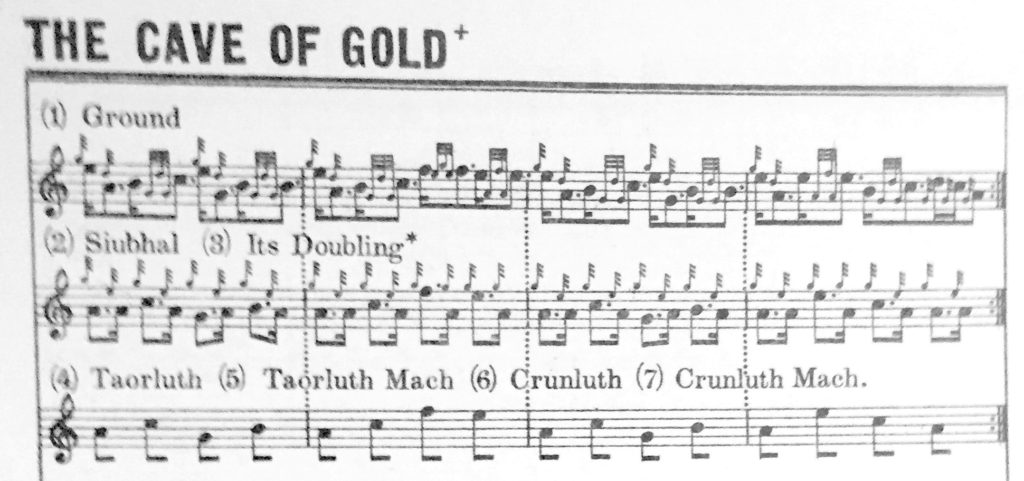
Just saying the words ‘Cave of Gold’ conjures up all the imagery and romance that a modern day Ossian would have been proud of. In reality the eponymous piobaireachd, MacCrimmon by repute, is a fairly bland piece and not close to the zenith of that family’s creative canon. We can forget all idea of swooning fairies cavorting to the music of a celtic Croesus, to a melody of brilliant glister.
If indeed it does belong to the family of Donald Ban, it may have been one of their first forays into the composing art; it resonates the ‘prentice pen. In the hands of a master, however, it can become something worth listening to and we are fortunate to be able to hear a performance of it now on the Piping Press Audio Archive. It is played by RU Brown, Balmoral, in a recording made for George Ackroyd, South Africa, probably in the 1960s. We thank Jimmy McIntosh for it.
Aficionados will be impressed firstly by a well-tuned bagpipe – the lodestone of all good ceol mor – by the sensitive phrasing, and finally by the zippy, polished technique: professional taorluaths and crunluaths not the half-open, laboured movements we sometimes hear even at the highest level.

The tune itself is published in Jimmy’s book ‘Ceol Mor for the Great Highland Bagpipe’ in a transcription accurately reflected in P/M Brown’s playing. In the audio Brown tells us he got his setting from a Scots émigré in Vancouver, Canada. It is similar to versions found in GF Ross’s two books published by bagpipe maker Peter Henderson ‘Some Piobaireachd Studies’ (1926) and ‘A Collection of MacCrimmon and other Piobaireachd’ (1929).

The tune has two stylistic idiosyncrasies. The first is the F gracenote used in the dithis in Ross’s later setting, and written as we play it in, say, an E doubling. It is hard to tell whether Brown plays these or merely substitutes high Gs. (To digress, why do we never have practice scales of F gracenotes when they feature in so many of our movements, especially in ceol mor?) The other is the unusual and difficult ‘bubbly note’ to low A at the ends of lines in the urlar. Brown copes with these admirably, never allowing clumsiness to detract from the melodic line.
The Piobaireachd Society have included the tune in their new Book 16. Here this figure has been re-written to hodrodin rather than hodaradin, giving the C the status of a melody note rather than that of a gracenote – a significant departure from tradition and one not heard before in my listening lifetime.


The PS editors have also chosen to adopt Ross’s second edition dithis with F gracenotes, but to rewrite these as semiquavers à la His Father’s Lament for Donald MacKenzie so making them part of the melody rather than an embellishment thereof; a completely different character to the variation is wrought.
There is nothing wrong with editors of music books choosing to make changes to scores as their musical taste dictates, and those outlined above are properly mentioned in the Cave of Gold notes in Book 16. This notwithstanding, when abbreviated the GF Ross/ RU Brown setting does not take up much space and I think the interests of authenticity would have been served better had the actual score been included with the note. Pipers could then have more readily decided for themselves which they preferred. It remains to be seen whether the PS setting will find favour with the piobaireachd enthusiast.
For now I can recommend a listen to Bob Brown making the most of this fabulously named tune’s scant melodic ingredient.
















Recent Comments